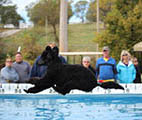Diagnostic Work-Up for Dogs With Seizures
General Diagnostic Work-Up
Veterinarians differ considerably in terms of the nature and number of tests that they recommend for a general diagnostic work-up when seizures begin. There is no one single set of tests that is appropriate for every dog. However, we present the tests and examinations described below as a general guideline. Veterinarians also differ in terms of whether a thorough diagnostic work-up should be done after the first seizure or whether the owner should wait until at least one other seizure has occurred. Of course, the owner’s personal circumstances must be taken into consideration. However, if possible, we recommend that the owner does not wait until a second seizure has occurred. There are many disorders that can cause seizures besides idiopathic (primary, inherited) epilepsy. A thorough diagnostic work-up is needed to determine if any of these other disorders are present and require treatment.
- Complete physical examination. A thorough physical examination can reveal a variety of factors that can cause seizures. For example, examination of the eyes may reveal signs of infectious disease. Abnormal heart and lung sounds may suggest problems that prevent enough oxygen from getting to the brain. Careful examination and palpation of the body may reveal possible tumors. These are just a few examples.
- Neurological examination. On a general level, a neurological exam involves testing the dog’s reflexes, examining his or her coordination, limb strength, position of head, cranial nerve responses, and general attitude. Signs of neurological problems that occur in between seizures suggest disorders other than idiopathic (primary) epilepsy.
- Complete blood count.
- Serum Chemistry Profile (after 12-hour fast).
- Urinalysis.
Together, numbers 3, 4, and 5 can detect a fairly large number of metabolic, infectious, and toxic disorders/diseases that can contribute to seizures.
- Test of liver function, usually bile acids, both 12-hour fasting and 2-hour postprandial (post-meal). This provides an accurate assessment of liver function. With respect to the postprandial test, the “meal” should not be a full meal. Rather, it should be a high protein, high fat snack designed to stimulate the release of bile acids. (Give two to four tablespoons of canned food, preferably a growth or recuperative formula.) The main advantage of doing the postprandial bile acids (which many veterinarians do not perform routinely) is to get a sensitive test of whether the dog may have a portosystemic shunt or cirrhosis. Other tests of liver function may be recommended, depending on your dogs breed or specific preferences of the attending veterinarians.
- Tests for suspected poisons. When exposure to specific poisons is suspected, tests for these should be performed. Common examples include lead (for example, from chewing old paint chips or linoleum) and organophosphates (from exposure to pesticides).
- Tests for suspected infectious diseases. Occasionally, a specific infectious disease is highly suspected due to the dog’s particular history. Some of these diseases (for example, toxoplasmosis, Lyme disease) require specific blood tests for accurate diagnosis.
- Owner observations (commonly called the “history”). Importantly, the owner should provide the veterinarian with as much information about their dog as possible. Often, owners are the only ones who have knowledge of some important diagnostic information. Understandably, owners will be stressed and will not be thinking their best when their dog has been having seizures. However, the more information owners can provide to their veterinarian, the better able he or she will be at diagnosing the problem.
- First, owners should provide a good description of the seizure episode(s), including the sequence of behaviors that occurs within the episode, the duration (length) of an individual episode, whether episodes vary in terms of what they look like, conditions under which episodes occur, etc.
- Owners also should report any neurological signs that occur in between seizures. (This is not to be confused with the post-ictal period, which is the period right after the seizure has ended, when the effects of the seizure may still be noticeable. The post-ictal period can range between a couple minutes to a couple days). Neurological signs that the owner may notice in between seizures can include: unusual gait, head tilt, impaired vision (suggested by bumping into things or not responding to moving objects on one side), restlessness, irritability, disorientation, etc. Neurological signs also can include changes in personality, such as a loss of housetraining, hiding behind a sofa or in a bathtub, vocalizing all night, etc.
- Owners also should report any medical signs, such as diarrhea, vomiting, runny nose, weight loss or weight gain, fatigue, skin problems, etc. These signs can suggest a variety of disorders, some of which may require additional testing.
- It also is important that the veterinarian has the dog’s complete medical history, including prior diseases, old or recent injuries (especially head injuries that are severe enough to have caused loss of consciousness), vaccination history, disorders that are known to run in the dog’s family, etc.
- Thyroid panel. A number of veterinarians suggest that hypothyroidism (low level of thyroid hormones) may cause seizures, or at least exacerbate seizures in epileptic dogs. However, these assertions are somewhat controversial, particularly in dogs that are not showing visible signs of hypothyroidism. Nonetheless, a number of veterinarians do recommend a thyroid panel.
- Further tests (such as brain imaging, cerebral spinal fluid tap, x-rays, electroencephalogram, etc.) may be recommended if the dog shows abnormal findings on any of the above, or if idiopathic epilepsy seems unlikely. For example, idiopathic epilepsy is much less likely when seizures occur for the first time in very young or very old dogs.
ISSUES RELATED TO AGE
Although seizures from idiopathic epilepsy can begin at almost any age, it is most common for seizures to begin between 1 and 5 years of age. When dogs begin having seizures at a much younger or much older age, it is important to give extra consideration to other possible causes.
When dogs begin having seizures at less than one year of age, seizures often are due to infectious diseases (for example, distemper virus) that affect the central nervous system. Also likely are congenital (present at birth) defects such as hydrocephalus or a portosystemic shunt. Hypoglycemia (due either to infectious disease, parasites, or metabolic disorder) also is a common cause of seizures at this age, particularly in small breeds. Because puppies are likely to chew on almost anything, the ingestion of poisons also should be suspected with young dogs.
When seizures begin in much older dogs, brain tumors are highly suspect. Tumors can either be primary or secondary. Primary tumors begin in the brain, and are of brain tissue origin. Secondary tumors (metastatic) begin elsewhere in the body and spread to the brain. If your veterinarian suspects secondary tumors, he or she may recommend chest and abdominal radiographs, as well as a referral to a neurologist. Although a brain tumor is a serious diagnosis, it may be treatable, especially if diagnosed early.
As a tumor enlarges in the brain, the pressure put on brain structures may cause additional neurological signs (see #9b above “Owner Observations”) in between the seizure episodes. Thus, the owners should keep a careful eye out for these additional signs since this information can help their veterinarian diagnose the problem. However, showing these signs is by no means completely diagnostic, and the lack of additional signs in no way eliminates the possibility of a brain tumor as the cause of the seizures. Positive diagnosis of a brain tumor can only be made with certainty using a brain scan (MRI or CT scan).
Another kind of tumor that can cause seizures, particularly in older dogs, is a pancreatic tumor that produces too much insulin. This will lead to hypoglycemia (low blood sugar). In general, you will see at least a hint of this if you do the tests recommended above. Confirmation of the problem will require further testing.
In the veterinary literature, relatively little is written about cerebrovascular disease (for example, strokes) as a cause of seizures. However, in humans, strokes are a common cause of seizures that begin late in life. Therefore, some veterinarians suspect that this also may be true for older dogs.
ISSUES RELATED TO ENVIRONMENT
Sometimes seizures begin after a move to a new home. Thus, checking out the new home and yard for potential poisons is important. Of course, it also is advisable to check out a current home and yard since poisons may be uncovered by your dog at any time. It also is possible that a dog can get injured in the process of moving to a new home.
If the home is an older house that was remodeled, it is possible that old lead-based paints were exposed, and the dog may have chewed some old paint chips. Similarly, old linoleum, which contains lead, may be uncovered during remodeling. Some older homes still may have lead pipes. Thus, the water may contain lead. It also is useful to check with the previous owners or landlord to determine what pesticides or herbicides had been used in the house or yard. If the new home previously was a farm, it is important to check for old batteries (a source of lead exposure) containers of pesticides, fungicides, or herbicides that may have been left. Another possibility is that the dog may have eaten some poisonous plants, although this is very rarely a cause of seizures in dogs.
Owners sometimes wonder about the stress of moving to a new home. In many dogs and humans, stress can indeed be a trigger for seizures. However, stress is not likely to be the sole cause. When stress is the trigger, it is likely that there are other predisposing factors that make the individual vulnerable to seizures. For example, stress (either psychological or physical) can trigger seizures in a dog that has inherited idiopathic epilepsy. Stress also can cause behavioral changes (such as changes in eating or drinking) or hormonal changes that may exacerbate already existing physical problems. Thus, it is important to look for other factors besides stress that predispose an individual to seizures.
©Barbara G. Licht PhD, 2010
Used with Permission
Updated 3/1/2010
The information contained in these documents is current at the time of this writing and is accurate to the best of VIP’s knowledge.
This information has been provided to you at no charge. You are free to use it provided it is used in its entirety with no changes or alterations and that the copyright remains intact. If you have found this information to be helpful, please consider making a tax-deductible donation to:
Versatility in Poodles
4061 Highlands Rd
Franklin, NC 28734
To make a donation via PayPal, please click the Donate Button:
The contents of the www.vipoodle.org website, such as text, graphics, images, and other material contained on this site (“Content”) are for informational purposes only. The Content is not intended to be a substitute for professional veterinarian advice, diagnosis, or treatment. Always seek the advice of your veterinarian with any questions you may have regarding the medical condition of your pet. Never disregard professional advice or delay in seeking it because of something you have read on this website!
If you think your pet has a medical emergency, call or visit your veterinarian or your local veterinary emergency hospital immediately. Versatility in Poodles and www.vipoodle.org do not recommend or endorse any specific veterinarians, products, procedures, opinions, or other information that may be mentioned on this website. Reliance on any information appearing on this website is entirely at your own risk.















